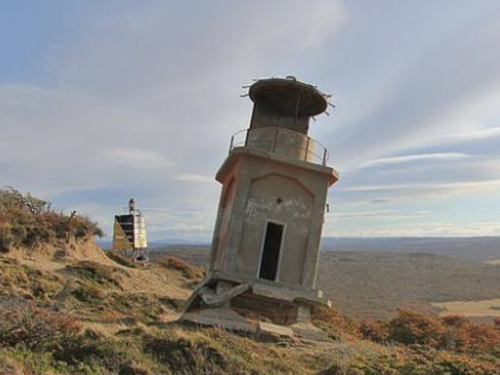Argentina (officially the Argentine Republic, República Argentina) is the second largest country of South America and has a population approaching 50 million. Located on the southern east coast of the continent, Argentina has a lengthy coastline on the South Atlantic Ocean, extending from the warm waters of the Río de la Plata to the edge of the cold Southern Ocean.
Colonized by Spain in the mid 1500s, Argentina secured its independence and territorial integrity in series of uprisings between 1810 and 18i6. Several decades of controversy and conflict established the organization of the country and its borders with its neighbors to the north. Between 1878 and 1884 Argentina expanded its control southward, occupying the region of Patagonia east of the Andes Mountains.
Argentina is a federation of 23 provinces (provincias) plus the autonomous capital city of Buenos Aires. This page includes lighthouses of the southernmost part of the country, the islands of Tierra del Fuego. Separated from the mainland by the Strait of Magellan, Tierra del Fuego was claimed by both Argentina and Chile. Under the Boundary Treaty of 1881 the main island was divided between the two countries along the longitude line of 68°34' W while the smaller islands to the south were assigned to Chile. An effect of the treaty is that the entire Strait of Magellan, including its eastern entrance, is in Chile; this leaves a gap in the Argentine coastline at the Strait entrance.
Most visitors to Argentine Tierra del Fuego arrive by air or cruise ship, but it is possible to drive to the island, crossing the Strait by ferry at Punta Delgada, Chile. National Route 3, a paved highway, extends to Ushuaia on the south coast overlooking the Beagle Channel.
Argentine Tierra del Fuego is part of the province known as Tierra del Fuego, Antártida e Islas del Atlántico Sur. Officially the province includes the Falkland Islands and South Georgia (both administered by Great Britain) plus the South Sandwich Islands and the wedge-shaped slice of Antarctica claimed by Argentina (although national claims for these territories are suspended by the Antarctic Treaties). The Tierra del Fuego portion of the province is divided into three districts called departments (departamentos).
The Spanish word for a lighthouse is faro; smaller lighthouses are often called balizas (beacons). In Spanish isla is an island, cabo is a cape, punta is a promontory or point of land, péñon is a rock, arrecife is a reef, bahía is a bay, ría is an estuary or inlet, estrecho is a strait, río is a river, and puerto is a port or harbor.
Active lighthouses in Argentina are owned by the Argentine Navy and managed by the Navy's Servicio de Hidrografía Naval (SHN).
ARLHS numbers are from the ARLHS World List of Lights. SHN numbers, where available from Spanish Wikipedia, are from the Argentine light list, Faros y Señales Marítimas. Admiralty numbers are from volume G of the Admiralty List of Lights & Fog Signals. U.S. NGA List numbers are from Publication 110, except that lights of the Beagle Channel are from Publication 111. The official Argentine light list, Faros y Señales Marítimas, is not available online.
- General Sources
- Faros de Argentina
- Index to lighthouse articles and photos in the Spanish Wikipedia.
- Faros Argentinos
- Information and photos from the Argentine-based Faros del Mar website.
- SHN: Faros Argentinos
- Data and photos for the lighthouses maintained by SHN.
- Lighthouses in Argentina
- The ARLHS listing of Argentine lights; the society has photos for most of them.
- Faros Argentina
- Photos posted on Flickr.com by Carlos María Silvano.
- Online List of Lights - Argentina
- Photos by various photographers posted by Alexander Trabas. Many of the Tierra del Fuego photos are by Hendrick Martin Porath or Jim Smith.
- World of Lighthouses - Argentina
- Photos by various photographers available from Lightphotos.net.
- Lighthouses in Argentina
- Photos available from Wikimedia.
- GPSNauticalCharts
- Navigational chart for Argentine Tierra del Fuego.
- Google Maps
- Satellite view of Argentine Tierra del Fuego.

Cabo Sebastián Light, Tierra del Fuego, June 2022
Google Maps photo by Marcelo Baiz











